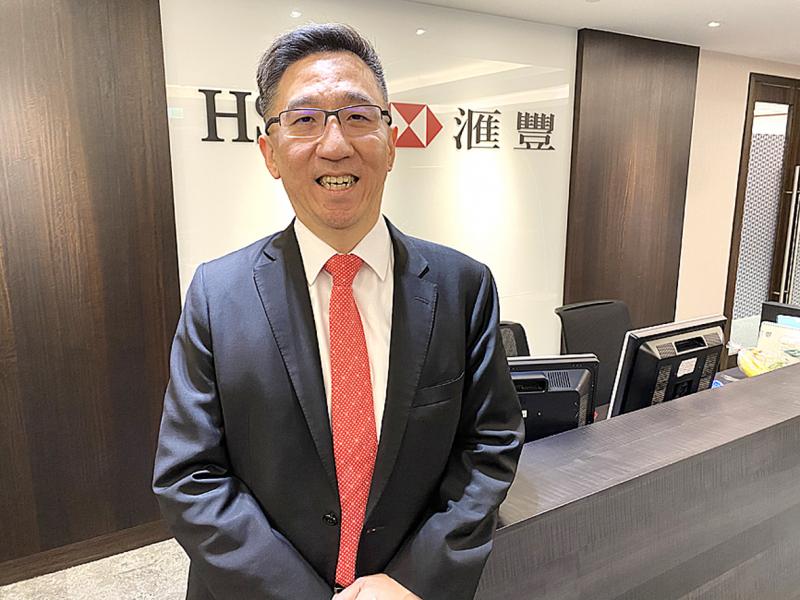Taipei Times (TT): Offshore wind power development is a new field to Taiwanese. How does HSBC Taiwan Ltd (匯豐台灣商銀) assess the risks of lending to the offshore wind developers working on their projects?
Adam Chen (陳志堅): First of all, we focus on the developers themselves. We check if they are HSBC’s existing clients, if they have experience in offshore wind power and if they can deliver in Taiwan. If the foreign companies are already clients of HSBC, we would have access to their credit profile. So, in principle, we prioritize the developers that HSBC is familiar with, as we would feel safer.
It is not that we would not finance the local developers that have never established offshore wind farms, but for potential clients, we need more communication to evaluate their commitment to the projects, their financial strength and their capability to establish wind farms.

Photo: Kao Shih-ching, Taipei Times
Second, we review the financing conditions proposed by developers and see if they are reasonable. Developers tend to have different ideas about loan structures due to their various experiences in other countries. Some might not fit in the local situation, and some might need more negotiation.
We also need to review other participants in the project, such as the contractors, suppliers and vessel providers. We look at the whole picture, and if we do not feel safe about some parts, we might feel more hesitant about financing the projects.
TT: Developers used to prefer selling power to the government to secure a better price, but Orsted Taiwan Ltd (沃旭能源) chose to sell power to Taiwan Semiconductor Manufacturing Co (台積電) from 2025. If more private companies enter the market as buyers, how would that reshape the financing risks?
Chen: New buyers of offshore wind power would be very welcome, as they would help the green power market develop in a healthier way. The market would want to see a balance between government and private-sector buyers.
There are likely new risks we would face. We need to check the new buyers’ credit profiles.
While the government signs a 20-year power purchase agreement with the developers to buy their energy at fixed prices, private companies might only want to buy the power for 10 or 15 years, but these are just a few among many risk factors considered, and they could be managed.
For example, we can help or suggest that the developers find other new clients to continue buying wind power for another 10 years.
We need to evaluate the risks with new methods if the buyers are private companies instead of the government, but overall, the risks would be reduced with diverse buyers, compared with Taiwan Power Co (台電) being the sole buyer.
TT: Why did most lending to offshore wind developers in Taiwan follow the new project financing model, which was relatively unknown in the nation?
Chen: That is because offshore wind projects are suitable for the model, as they are expected to generate revenue for 20 years once they begin operations, which matches project finance relying primarily on the project’s cash flow for repayment.
Project financing is often used in funding long-term infrastructure or industrial projects, but project financing with a 20-year term is not often seen, as most loan terms range from five to 10 years.
While one offshore wind developer sought corporate loans, with its parent company willing to guarantee the lending, not all offshore wind developers are willing to follow the same path. Most of them prefer project financing as they do not need to put up many assets as collateral, so they can fund major projects off-balance-sheet.
TT: How do you organize the project financing structure to reduce risks?
Chen: It is crucial for us to offload the risks. We negotiate with all involved parties to distribute the risks. Banks usually cover risks of foreign exchange or volatility in the financial markets, while other risks are covered by developers, contractors, suppliers and buyers.
We have penalty provisions in the deal to prevent participants from delaying. For example, if the contractor cannot finish its work on time or has any problems with the construction, it must pay penalties or liquidated damage to the project company, which would help the project continue and arrive at the finish line.
Generally, it is preferred to have fewer shareholding developers in a project at the initial development phase to be able to structure and negotiate more effectively. Meanwhile, they would be more committed to concluding the project. The shareholding developers would be able to sell their stakes when the construction of the wind farms is complete.
As there are a lot of issues to negotiate among all parties and banks, settlement on project financing for offshore wind project takes from 13 to 18 months on average.
TT: What are HSBC Taiwan’s advantages compared with local banks? And what is its outlook for the business?
Chen: HSBC Taiwan is in a great position to finance offshore wind projects, as the local government has a high commitment to developing green energy, [we have] the bankers with skills to develop infrastructure and energy project financing solutions and we can leverage the HSBC global network and access project developers around the globe.
That also explains why we are the sole issuer of guarantee letters to support the offshore wind power developers, after we issued a legal document for NT$3.6 billion for the construction of two wind farms developed by Copenhagen Infrastructure Partners in northwest Taiwan, because we know the developers’ profiles better.
We play the role of bridging the local government’s green energy development objectives and the interests of overseas developers. Each project financing [deal] has been carefully evaluated and tailored to meet the developmental requirements.
I personally have an upbeat outlook for financing offshore wind projects, as once the wind farms become operational, investors will feel more confident and commit more. The government is formulating the zonal development policy for offshore wind for the next 10-year stage from 2026 to 2035, so the business opportunities would be big.
We expect to continue collaborating with our local peers and to share our knowledge and experience with them, so banks can work together to support the business.

CHIP RACE: Three years of overbroad export controls drove foreign competitors to pursue their own AI chips, and ‘cost US taxpayers billions of dollars,’ Nvidia said China has figured out the US strategy for allowing it to buy Nvidia Corp’s H200s and is rejecting the artificial intelligence (AI) chip in favor of domestically developed semiconductors, White House AI adviser David Sacks said, citing news reports. US President Donald Trump on Monday said that he would allow shipments of Nvidia’s H200 chips to China, part of an administration effort backed by Sacks to challenge Chinese tech champions such as Huawei Technologies Co (華為) by bringing US competition to their home market. On Friday, Sacks signaled that he was uncertain about whether that approach would work. “They’re rejecting our chips,” Sacks

NATIONAL SECURITY: Intel’s testing of ACM tools despite US government control ‘highlights egregious gaps in US technology protection policies,’ a former official said Chipmaker Intel Corp has tested chipmaking tools this year from a toolmaker with deep roots in China and two overseas units that were targeted by US sanctions, according to two sources with direct knowledge of the matter. Intel, which fended off calls for its CEO’s resignation from US President Donald Trump in August over his alleged ties to China, got the tools from ACM Research Inc, a Fremont, California-based producer of chipmaking equipment. Two of ACM’s units, based in Shanghai and South Korea, were among a number of firms barred last year from receiving US technology over claims they have

It is challenging to build infrastructure in much of Europe. Constrained budgets and polarized politics tend to undermine long-term projects, forcing officials to react to emergencies rather than plan for the future. Not in Austria. Today, the country is to officially open its Koralmbahn tunnel, the 5.9 billion euro (US$6.9 billion) centerpiece of a groundbreaking new railway that will eventually run from Poland’s Baltic coast to the Adriatic Sea, transforming travel within Austria and positioning the Alpine nation at the forefront of logistics in Europe. “It is Austria’s biggest socio-economic experiment in over a century,” said Eric Kirschner, an economist at Graz-based Joanneum

France is developing domestic production of electric vehicle (EV) batteries with an eye on industrial independence, but Asian experts are proving key in launching operations. In the Verkor factory outside the northern city of Dunkirk, which was inaugurated on Thursday, foreign specialists, notably from South Korea and Malaysia, are training the local staff. Verkor is the third battery gigafactory to open in northern France in a region that has become known as “Battery Valley.” At the Automotive Energy Supply Corp (AESC) factory near the city of Douai, where production has been under way for several months, Chinese engineers and technicians supervise French recruits. “They